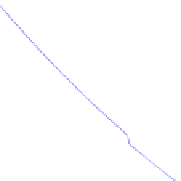Information Technology Reference
In-Depth Information
snapshots of the eye−in−hand camera at t=2.9341s
snapshots of the eye−in−hand camera at t=2.9556s
385
385
occlusion point
target point
occlusion point
target point
380
380
375
375
370
370
365
365
185
190
195
200
205
185
190
195
200
205
(a)
(b)
Fig. 14.12
Snapshots of the eye-in-hand camera
error
error
120
95
u1−u1d
v1−v1d
u2−u2d
v2−v2d
u1−u1d
v1−v1d
u2−u2d
v2−v2d
90
100
85
80
80
60
75
40
70
65
20
60
0
0
5
10
15
20
0
1
2
3
4
5
6
(a)
(b)
Fig. 14.13
Feature points motions
the detailed trajectory of the features error around
t
= 2
9341
s
isshowninFigure
14.13(b). We can see that the error still decreases exponentially, except the sawtooth
around
t
= 2
.
.
9341
s
, which corresponds to the activation of the artificial force.
14.5
Gradient Projection Method for Keeping Target Features
in the Field of View
In this section, we describe how gradient projection methods can be used to keep
target features in the camera field of view throughout the camera motion. Below,
we adopt a cost function proposed in [10], and describe the necessary methods for
exploiting this cost function in a gradient projection framework.
14.5.1
Basic Algorithm Design
One approach to keeping target features in the field of view is to construct a cost
function that takes a value equal to zero when target features are at the image center,

































































Search WWH ::

Custom Search